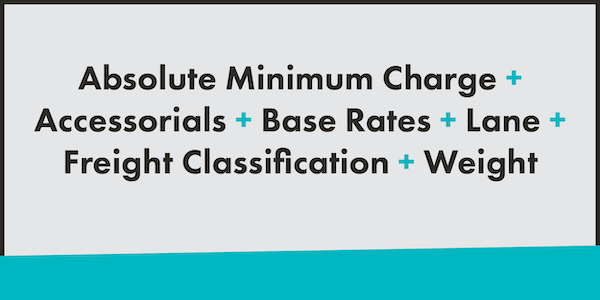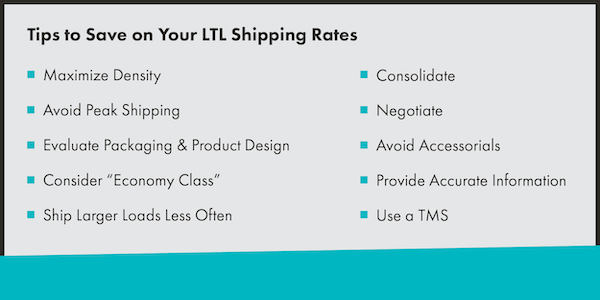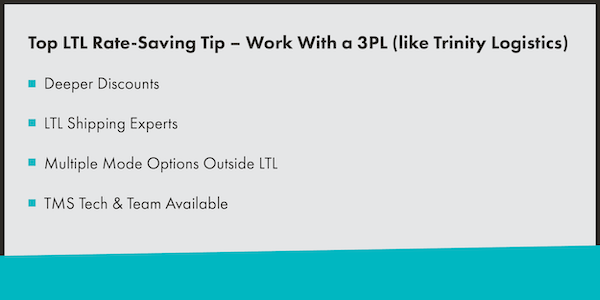
06/05/2024 by Christine Morris
Tips to Save on LTL Shipping Rates
Do you feel like you could be spending less on your less-than-truckload (LTL) shipping rates? Most likely, you’re right. LTL shipping rates are affected by many different factors, so it can be pretty easy to make these simple changes and see your shipping costs decrease. While these tips may not be possible for everyone or every shipment, hopefully, you’ll find one you can start implementing to reduce your freight costs.
HOW LTL SHIPPING RATES ARE CALCULATED
Compared to truckload rates, LTL shipping rates can be very confusing. To make it simpler, here’s what goes into your LTL costs.

Absolute Minimum Charge
This is the lowest rate a carrier will charge.
Accessorials
These are extra charges for any services provided by the carrier that are beyond simply shipping from one point to another. Examples of common accessorials include:
- Inside pickup or delivery
- Lift gate service
- Residential delivery
- Detention storage
Base Rates
Each LTL carrier sets its own base rate, often quoted per 100 lbs., and based on the freight classification, weight of the shipment, distance traveled, and the origin and destination zip codes.
Lane
The lane plays a role in the base rate. The further the distance traveled in the lane, the more costly the LTL shipping rate can be.
Freight Classification
The product you ship has its own classification based on the National Motor Freight Classification (NMFC). Freight that is dense and difficult to break is in a lower class, making it the least expensive. Lighter and more fragile freight is at a higher freight class and thus, costs more.
Weight
LTL shipping rates are based on the total weight and number of pallets. The heavier a shipment, the less it costs per hundred pounds, as factored by the base rate calculation.
HOW TO SAVE ON YOUR LTL SHIPPING RATES

Maximize Density
LTL carriers make a profit by fitting as many different LTL shipments into their trailers as safely as possible. So, which do you think they prefer – a shipment that takes up 25 percent of their trailer or a shipment that takes up 10 percent? The less space your shipment can take up, the less it could cost to ship it.
While the weight of your shipment may be out of your control, the density is not. Increasing density starts with how you pack your LTL freight. Experienced shippers know that doing everything they can to compactly pack their freight on pallets will reduce their LTL shipping rates.
So, do everything you can to make your shipment take up less space. If your current pallets are not stackable, find a way to make them, if possible. Reduce any empty space between cases or products on the pallet. If possible, stack an extra row on top of each pallet to eliminate using an extra pallet. Brainstorm all the ways to make your shipment take up less space, and you’ll likely see savings.
*It’s important to note that you should never negate safety or product quality to reduce your shipping rates!
Aim to Avoid Peak Shipping When Possible
While this may not always be possible, avoiding peak shipping times is an easy way to reduce your LTL shipping costs. When you can, plan and ship early or after peak times.
Evaluate Packaging and Product Design for Logistics
Now this tip is more of a hefty task, but it’s certainly one to consider. When in the early stages of product and packaging design, or even when re-evaluating, it’s ideal to get one of your logistics professionals involved. This will help your product and package designers consider details that can make your product easy to ship, stack, and organize. There’s nothing worse than having a great product only to end up with it being too cost-prohibitive to transport.
Consider “Economy Class” LTL Carriers
If your shipment isn’t time-sensitive, using “economy class” LTL carriers is an easy way to reduce your LTL shipping rates. Their rates are often cheaper but their transit times are longer, so you’re trading off higher costs for more time. If you have time to spare, this is a great option for savings.
Ship Larger Loads Less Often
As you likely know, it’s cheaper to ship several pallets at once than one at a time over a few weeks. However, to use this strategy, you’ll have to convince your customers to take on larger orders. You can offer them a price break or agree to share some of the savings you see in shipping to do so.
Consolidate to One Truckload
Eliminating a shipment altogether is a surefire way to reduce your freight costs.
Have you ever considered consolidating your LTL shipments into a multi-stop truckload shipment? Shipping a full truckload of freight is often far less expensive than shipping multiple LTL shipments.
Of course, it depends on where your shipments are delivering. For example, a multi-stop truckload picking up in Maine and delivering in Florida, Minnesota, and California might not make financial sense compared to shipping LTL. But if your delivery points are close to each other, or if they form a line across the country (at least vaguely), getting a quote on a consolidated truckload shipment would be very wise
If you don’t have enough for a full truckload, you could still consolidate and combine two or more LTL shipments into one. It’s worth it to see if any sort of consolidation can reduce your LTL shipping rates.
Negotiate with LTL Carriers
It never hurts to ask or negotiate for a discounted rate with your LTL carrier. Perhaps you can have an accessorial fee waived or reduced based on shipment frequency.
If you ship all kinds of freight, you may be able to negotiate freight of all kinds (FAK) for reduced LTL shipping rates. Rather than getting a rate for different classes of freight (which can be time-consuming and complicated), you negotiate to have all your LTL freight rated in the same class, with FAK, which not only saves you time but money.
You could also negotiate for Customer Specific Pricing (CSP). This is contracted pricing, which could include a FAK structure if needed. LTL CSP allows carriers to have a better picture of your freight which not only results in more efficient, but often cheaper, pricing since the rate contracts are ONLY based on your shipments.
Interested in LTL CSP? Let Trinity negotiate with LTL carriers on your behalf.
Avoid Accessorials When Possible
Accessorials in LTL shipping are common and some may be unavoidable, but many can be avoided when planning ahead. To avoid these extra charges, make sure to educate yourself on your LTL carrier’s guidelines and accessorial fees, aim to avoid weight, dimension, and oversizing adjustments, and ensure your bill of lading (BOL) is accurate. Taking these extra steps will ensure you don’t get hit with unexpected charges and keep your LTL shipping rates low.
Provide Accurate Information
Most shippers are aware that the rate for shipping their LTL freight is highly dependent on the size and weight. For this reason, some people are tempted to slightly underestimate the dimensions or weight of their shipment in the hopes it will result in a slightly lower shipping cost and the LTL carrier will be none the wiser.
Whatever you do, don’t do this! Rather than saving money, you may be opening yourself up to extra charges. Most carriers will double-check that the dimensions and weight of your shipment match what’s on the BOL. If it doesn’t match, you’ll be faced with extra, unexpected charges. Your shipment cost will be raised accordingly, but you’ll also be charged with an inspection or reweigh fee, and it’s possible the carrier will red flag your freight to be inspected every single time you ship with them, meaning you just caused increased LTL shipping rates for the future – the opposite of what you wanted.
Use a TMS for Efficiencies
Controlling your shipping costs can be difficult without having full visibility of your freight spend. So, if you’re really looking to take control of your freight costs, a transportation management system (TMS) is what you need. A TMS can give you clear insight into your logistics with comprehensive reporting so you can find more ways to save on your LTL shipping rates while also finding efficiencies in your operations.
WORK WITH A 3PL
Probably the quickest and easiest way to save on your LTL shipping rates and your time is working with a third-party logistics company (3PL), like Trinity Logistics.

Because of the high volume of freight that 3PLs arrange for all their customers, means we have lower contracted rates (aka deeper discounts) available that you otherwise wouldn’t be able to access. This will result in significant cost savings, especially over time.
Working with Trinity Logistics also gives you the benefit of working with logistics experts who can help you not only with your LTL shipping but any other modes you may need or be interested in. We’ll help you determine what other modes make sense and what other benefits or savings they could offer your business. We also have a dedicated Team to assist you with Managed Transportation or implementing a TMS if that’s something you may need now, or in the future as you grow.
Whether you simply need help saving on your LTL shipping rates or would like a valuable logistics partner on your side for all your logistics needs, our Team is ready to help you and your business succeed.
LEARN HOW TRINITY CAN HELP YOU WITH LTL SHIPPING START SAVING ON LTL SHIPPING RATES-GET A FREE QUOTE

